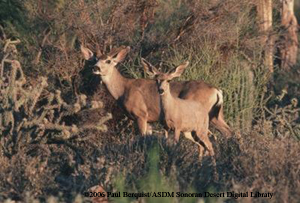Animal Fact Sheet: Mule Deer |
Identifying Features Mule deer (Odocoileus hemionus) are easy to identify due to their large mule-like ears. They are brownish-gray in color, have a white rump patch and a small white tail with a black tip. The male deer grow antlers during the summer and fall and shed them each spring. The antlers split off from the main branch forming two branches, each branch has 2 or more tines. |
 |
Adaptations These deer adapt to living in the desert by being active during the warm weather at night or during the early morning hours. They also have adapted to eating a wide variety of vegetation types in order to meet all of their nutritional needs. |
Habitat Mule deer can be found throughout desert regions as long as there is enough vegetation to hide in and to eat. They will move to higher elevations during the hottest parts of the summer and move to lower elevations during the winter months. They also are found in mountain forests, wooded hills and in chaparral. |
Range Mule deer are found throughout the entire western United States. |
Wild Status These deer currently are not threatened or endangered. Many states have purchased tracts of land in order to maintain the various habitats critical to the deer. |
Diet Mule deer eat a variety of vegetation. They are known to eat mesquite leaves and beans, fairy duster, jojoba, cat claw, buck bush and other shrubs and grasses. |
Predators Humans, coyote, mountain lion, eagles, bear, wolves, and bobcats. |
Home Mule deer will make temporary 'beds' which are usually nothing more than flattened areas of grass or leaves. If it is an area they use often, then they will use their hooves to scratch a level depression into the earth. |
Life Span Mule deer usually live 9-11 years in the wild and can live to be much older when in a zoological setting. |
Size These deer range from 3.0-3.5 feet tall at the shoulder, 4.5-7.0 feet long and have a tail that is 5.0-8.0 inches long. they can weigh between 130-280 pounds. The female deer are smaller than the male. |
Quick Facts
|
 ©Copyright 2008, Arizona-Sonora Desert Museum
©Copyright 2008, Arizona-Sonora Desert Museum










